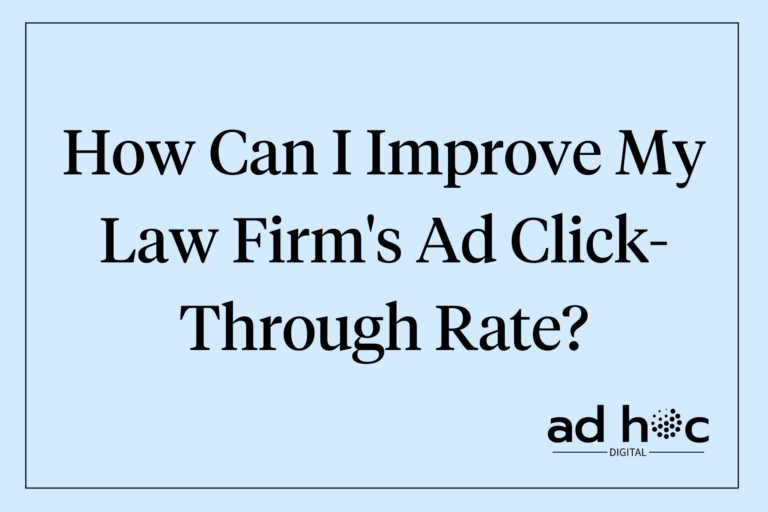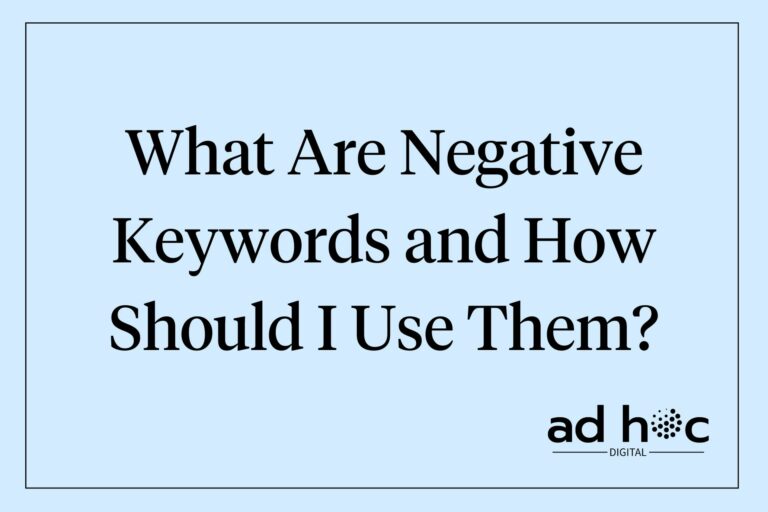An optimized landing page is mandatory when running Google Ads for your law firm.
Effective landing pages can significantly improve your conversion rates and maximize the return on your advertising spend.
This comprehensive guide will detail all the best practices for creating Google Ads landing pages tailored for law firms.
Explore our guide on successful Google Ads campaigns tailored for lawyers to build a solid foundation in effective campaign creation.
Understanding Landing Page Basics
Definition of a Landing Page
A landing page is a standalone web page created specifically for an advertising or marketing campaign. It’s where a visitor “lands” after clicking on a Google Ad.
Unlike general web pages, landing pages are designed with a single focus or goal, known as a call to action (CTA).
The primary purpose of a landing page is to drive visitors towards completing a specific action, such as filling out a contact form, signing up for a newsletter, or calling a number.
Because there are no distractions it works well to guide users directly to the intended conversion goal. This is super important when you are paying for traffic (like with any advertising platform).
Role in Google Ads Campaigns
Landing pages are crucial for converting ad clicks into leads. When a user clicks on your Google Ad, they expect to find information that directly relates to the ad they clicked on. A well-designed landing page that matches the intent of your ad can significantly improve your conversion rates and reduce your cost per conversion.
In practice we have had situations where conversion rates more than doubled from simply changing from a website to a landing page.
This alignment between your ad and landing page content creates a seamless user experience, increasing the likelihood that visitors will complete the desired action.
For example, if your ad promotes legal services for car accident cases, the landing page should specifically address car accident law not just personal injury law, provide relevant information, and include a clear CTA, such as “Schedule a Free Consultation.” Consistency in messaging between the ad and the landing page reassures visitors that they are in the right place and encourages them to proceed with the conversion.
Key Elements of an Effective Landing Page
Clear and Compelling Headline
Your headline is the first thing visitors see, and it needs to grab their attention immediately. A strong headline should be:
- Clear and Relevant: It should directly relate to the content of the ad that led the visitor to your landing page. If your ad was about car accidents, your headline might be, “Get Expert Legal Help for Your Car Accident Case.”
- Compelling: It should spark interest and encourage the visitor to read further. Use power words that evoke emotion or curiosity.
- Concise: Keep it short and to the point. A headline that is too long can overwhelm visitors and lose their interest.
A clear and compelling headline sets the tone for the rest of the page and ensures that visitors know they are in the right place.
Here are some basic examples to help you get started:
| Practice Area | Example Headline |
| Personal Injury | “Injured? Get the Compensation You Deserve” |
| Car Accidents | “Get Expert Legal Help for Your Car Accident Case” |
| Family Law | “Navigate Your Divorce with Confidence and Care” |
| Criminal Defense | “Fight Your Charges with a Top Criminal Defense Lawyer” |
| Estate Planning | “Secure Your Future with Expert Estate Planning” |
| Business Law | “Protect Your Business with Our Legal Expertise” |
| Intellectual Property | “Safeguard Your Ideas with Proven IP Protection” |
| Employment Law | “Stand Up for Your Rights with Our Employment Lawyers” |
| Immigration Law | “Achieve Your Immigration Goals with Our Legal Support” |
| Real Estate Law | “Navigate Real Estate Transactions with Confidence” |
Engaging Visuals
Visual content is crucial for capturing attention and making your landing page more appealing. Effective visuals include:
- High-Quality Images: Use professional, high-resolution images that are relevant to your services. For a law firm, images of your team, office, or clients (with their consent) can humanize your brand.
- Videos: A short, informative video can explain your services better than text alone. Videos can increase engagement and conversion rates by providing a quick overview of what you offer.
- If you are good on camera this can work especially well.
- Consistent Branding: Ensure that the visuals align with your brand’s color scheme, fonts, and overall aesthetic. Consistent branding helps build recognition and trust.
Concise and Persuasive Copy
The text on your landing page should be:
- Concise: Visitors typically skim content, so use short paragraphs, bullet points, and headers to break up the text. Get to the point quickly to keep their attention.
- Persuasive: Highlight the benefits of your services and how you can solve the visitor’s problem. Use persuasive language that speaks directly to the visitor’s needs and pain points.
- Clear and Simple: Avoid jargon (legalese) and complex sentences. Your goal is to communicate your value proposition as clearly and quickly as possible.
Effective copywriting can significantly increase the likelihood of converting visitors into leads.
Strong Call to Action (CTA)
A strong CTA is crucial for guiding visitors towards taking the desired action. Key aspects include:
- Clear and Direct: Use action-oriented language that tells visitors exactly what to do next, such as “Schedule Your Free Consultation” or “Call Us Now.”
- Compelling: Make the CTA enticing by emphasizing the benefits of taking action. For example, “Get a Free Case Evaluation Today.”
- Prominently Placed: Ensure the CTA is easily visible on the page. It should stand out through the use of contrasting colors and strategic placement above the fold (visible without scrolling).
We typically implement a ‘sticky’ header with a phone number call to action on all landing pages, and above the fold we have a form that is easily accessible.
Trust Signals
Trust signals are elements that build credibility and reassure visitors that they are making the right choice by contacting your firm. Effective trust signals include:
- Client Testimonials: Real feedback from satisfied clients can provide social proof and build trust. Ensure these testimonials are genuine and specific.
- Awards and Certifications: Highlight any awards, recognitions, or certifications your firm has received. This can enhance your credibility and demonstrate your expertise.
- Professional Affiliations: Display memberships in professional organizations or associations, such as the American Bar Association or local bar associations.
- Case Studies: Share detailed case studies that outline how you have successfully helped clients in the past. This can provide concrete examples of your capabilities.
This can make a significant difference and it can be the difference between an average landing page and an incredible landing page.
Design and User Experience (UX)
Design and User Experience (UX) focuses on creating a seamless, intuitive, and engaging interface for users, ensuring your landing page is visually appealing, easy to navigate, and responsive across all devices to enhance user satisfaction and improve conversion rates.
Mobile Responsiveness
Ensure that your landing page is mobile-responsive. With an increasing number of users accessing websites on their mobile devices (64%), a responsive design is crucial for providing a seamless user experience across all devices.
A mobile-responsive design adapts to different screen sizes, ensuring that your content is easily readable and navigable on smartphones and tablets.
This not only improves user satisfaction but also positively impacts your quality score as Google heavily prioritizes mobile-friendly sites.
The amount of firms that we see with a landing page (or website) that isn’t well optimized for mobile is incredible. This greatly increases client acquisition costs.
Fast Load Times
Page speed is critical. A slow-loading page can frustrate visitors and lead to high bounce rates.
For me personally, if a page doesn’t load quickly I usually just click off and go to the next one…
Optimize your landing page to load quickly, ideally within 2-3 seconds.
To achieve this, minimize the use of heavy images and videos, leverage browser caching, and use content delivery networks (CDNs) to deliver your content more efficiently.
Tools like Google PageSpeed Insights can help identify performance issues and provide recommendations for improvement. Fast load times not only enhance user experience but also contribute to better quality scores, as search engines Google heavily favors fast-loading pages.
Easy Navigation
Simplify the user journey by making your landing page easy to navigate. Remove any unnecessary elements that could distract visitors from the main goal. Use clear and straightforward navigation to guide users towards your CTA.
This includes a clean layout, intuitive menu structures, and prominent buttons that lead to important sections of your page. Ensure that all links and buttons are easily clickable and that the navigation is consistent across the page. Simplified navigation helps visitors find what they’re looking for quickly, reducing frustration and improving the likelihood of conversion.
Form Design
Optimize your contact forms for conversions. Keep them short and only ask for essential information.
The easier it is for visitors to complete the form, the more likely they are to do so. Limit the number of fields to the minimum required to qualify leads, and consider using features like autofill and inline validation to make the process smoother.
Normally we include the bare minimum fields with autofill and automatic number and email validation. The more fields the higher the cost per lead ALWAYS.
Ensure that the form fields are clearly labeled and that the submit button is prominent and compelling. Additionally, provide reassurance by including privacy statements or trust badges near the form to alleviate any concerns about data security.
Relevance and Consistency
Alignment with Ad Copy
Ensure that your landing page aligns with the content and intent of your Google Ad. Consistency between your ad and landing page improves user experience and increases the likelihood of conversion. When users click on an ad, they expect the landing page to reflect the promise or offer mentioned in the ad.
For example, if your ad highlights a “Free Consultation for Car Accident Cases,” your landing page should prominently feature this offer. Consistent messaging reassures visitors that they are in the right place and reinforces the value proposition that attracted them to click on your ad initially.
Keyword Relevance
Use keywords from your ad campaign within your landing page content. This also reassures visitors that they are in the right place and that your page is relevant to their search. Including targeted keywords in your headlines, subheadings, and body text improves your page’s relevance both for users and search engines.
For instance, if your ad targets “Experienced Family Law Attorney,” incorporating this phrase naturally into your landing page text will make it clear to visitors that your services match their needs. This alignment boosts your quality score and enhances user confidence.
- Note: You should avoid keyword stuffing at all costs! Users hate it, and Google punishes it heavily. Though it may have worked in the past, now it is a sure fire way to get worse results.
Consistent Branding
Maintain consistent branding across your ads and landing pages. This includes using the same logos, color schemes, fonts, and messaging style to create a cohesive experience for visitors.
Consistent branding helps build trust and recognition, making your firm appear professional and reliable.
For example, if your ad features a specific color palette and logo, ensure these elements are mirrored on your landing page. Consistent visual and textual branding reinforces your firm’s identity and makes the transition from ad to landing page seamless. This cohesiveness can significantly improve user retention and conversion rates.
For more on creating cohesive campaigns, see effective Google Ads campaigns for lawyers. This resource provides insights into maintaining consistency across various campaign elements to enhance overall effectiveness.
Tracking and Analytics
Setting Up Conversion Tracking
Set up conversion tracking in Google Ads to measure the performance of your landing pages. This will allow you to track critical actions such as form submissions and phone calls.
Conversion tracking helps you understand which aspects of your campaign are driving the most valuable interactions and allows you to optimize for those actions. By setting up conversion tracking, you can see how effectively your ads lead to user actions and refine your strategy accordingly.
Using Google Analytics
Integrate Google Analytics with your landing pages to gain deeper insights into user behavior. Track metrics such as bounce rate, average session duration, and pages per session to understand how visitors interact with your landing page.
For example, a high bounce rate might indicate that visitors are not finding the information they expected, prompting a need for adjustments in content or design. Average session duration and pages per session can provide insights into how engaging and navigable your landing page is, helping you identify areas for improvement.
A/B Testing
Perform A/B testing to compare different versions of your landing page. Test variations of headlines, images, copy, and CTAs to determine what works best. For example, you might test two different headlines to see which one generates more conversions or compare different CTA buttons to see which one prompts more user interactions. A/B testing helps you make data-driven decisions to optimize your landing page for better performance.
For more detailed strategies, visit A/B testing in Google Ads for lawyers.
Analyzing Metrics
Monitor key performance indicators (KPIs) such as conversion rate, click-through rate (CTR), and cost per conversion. Use these insights to continuously optimize your landing pages for better performance.
For instance, a low conversion rate may indicate a need to improve your CTA or landing page design, while a high cost per conversion might suggest the need to refine your ad targeting or bidding strategy. Regularly analyzing these metrics ensures that your landing pages remain effective and that your campaigns yield the best possible return on investment.
Legal and Ethical Considerations
Compliance with Advertising Rules
Ensure your landing pages comply with legal advertising rules and ethical guidelines. This includes being truthful in your claims, avoiding misleading information, and adhering to privacy regulations. For more on compliance, see legal compliance for Google Ads lawyers.
Privacy and Confidentiality
Protect client information by ensuring that your landing pages adhere to privacy laws and confidentiality standards. Use secure forms and clearly state your privacy policy to reassure visitors.
Conclusion
Creating effective landing pages for your Google Ads campaigns is essential for converting visitors into clients. By focusing on clear and compelling content, user-friendly design, relevance, and compliance, you can optimize your landing pages for better performance. Continuously monitor and improve your landing pages to ensure ongoing success.
Enjoyed this content? Subscribe to our newsletter for weekly updates on valuable resources.
Also if you wish to learn more about our services feel free to fill out the form below and we’ll contact you soon.



